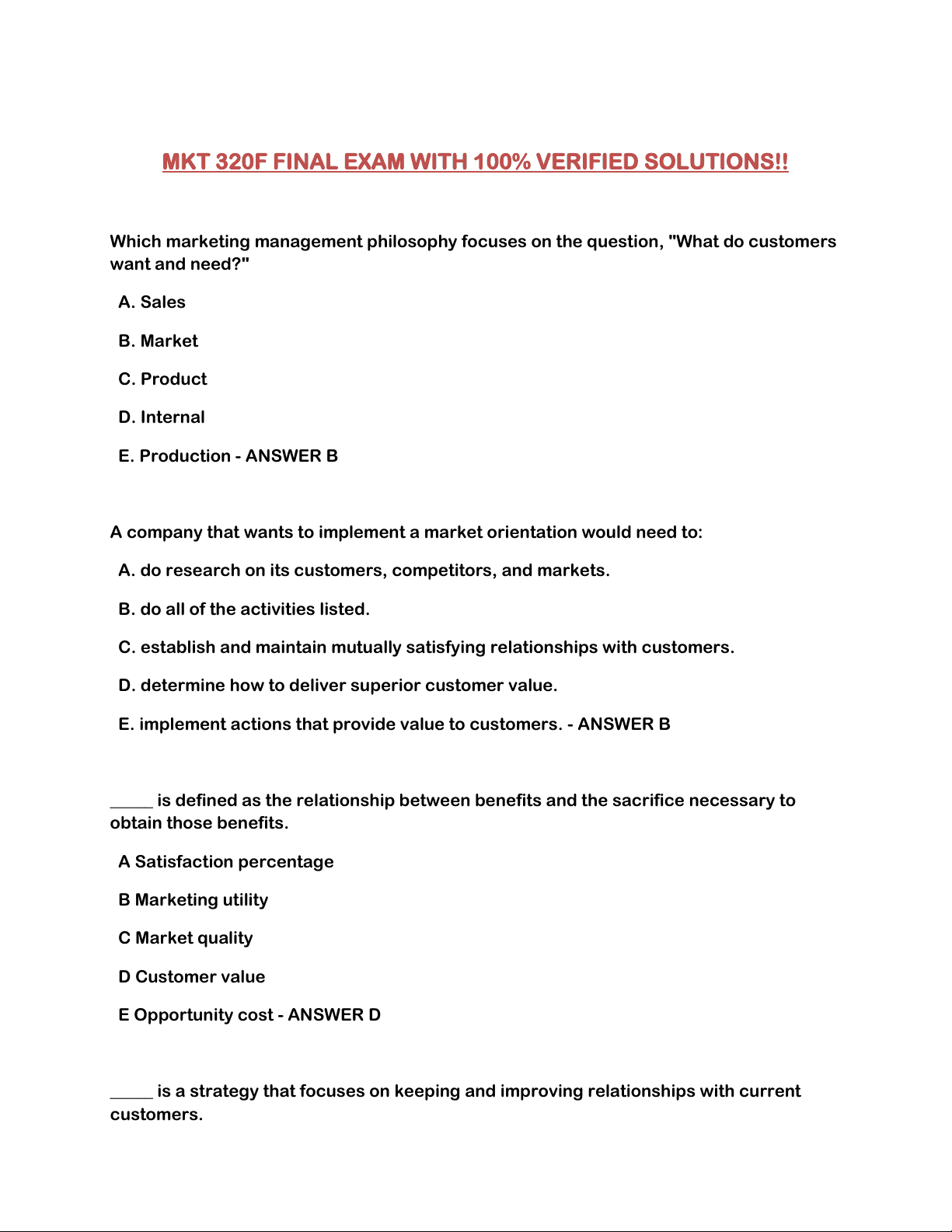
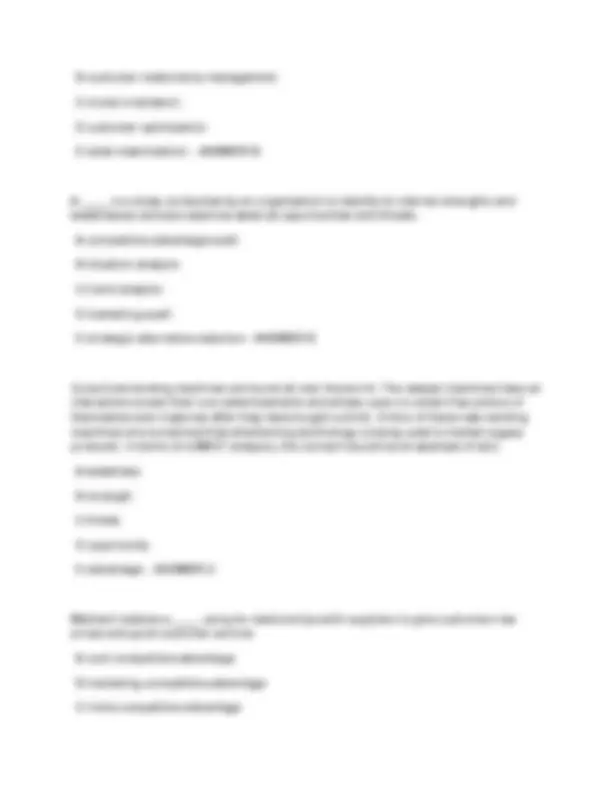

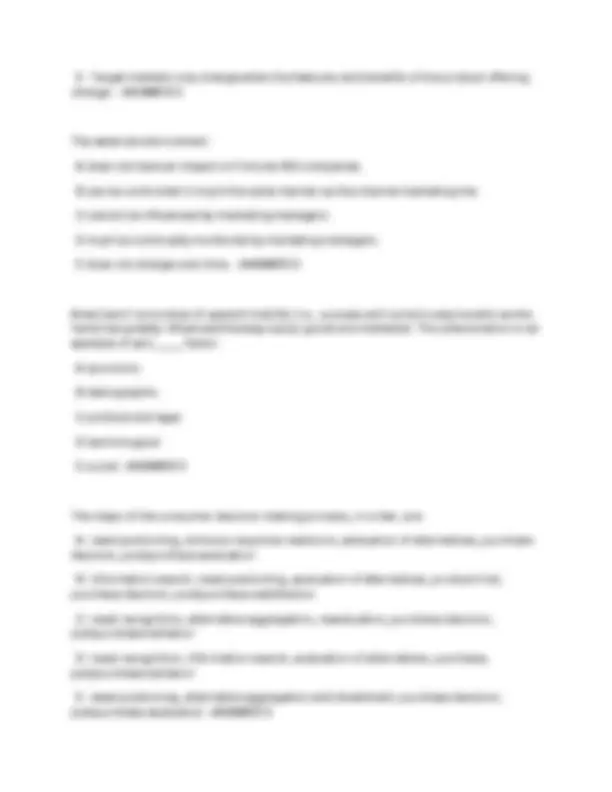
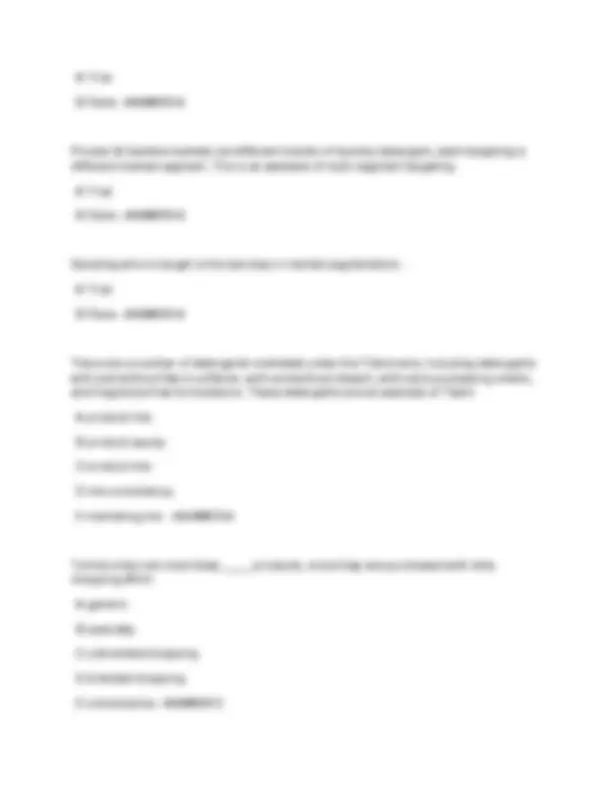
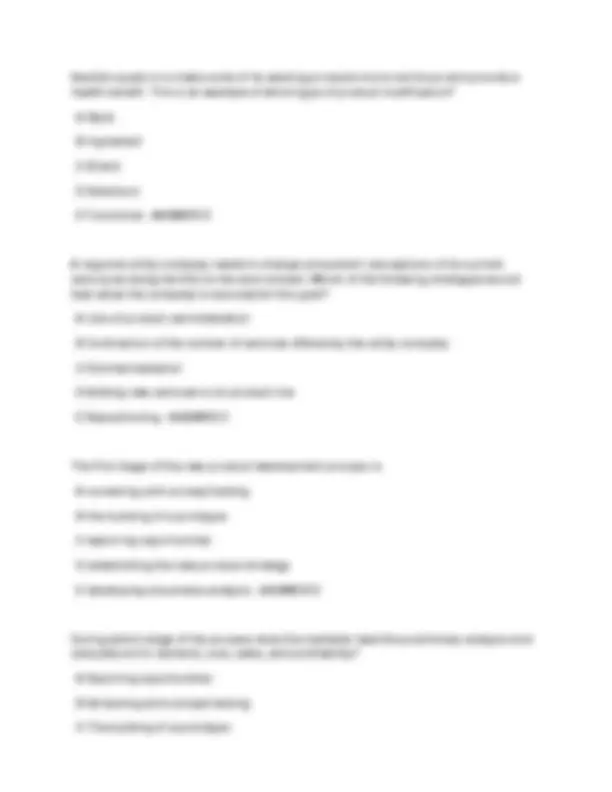
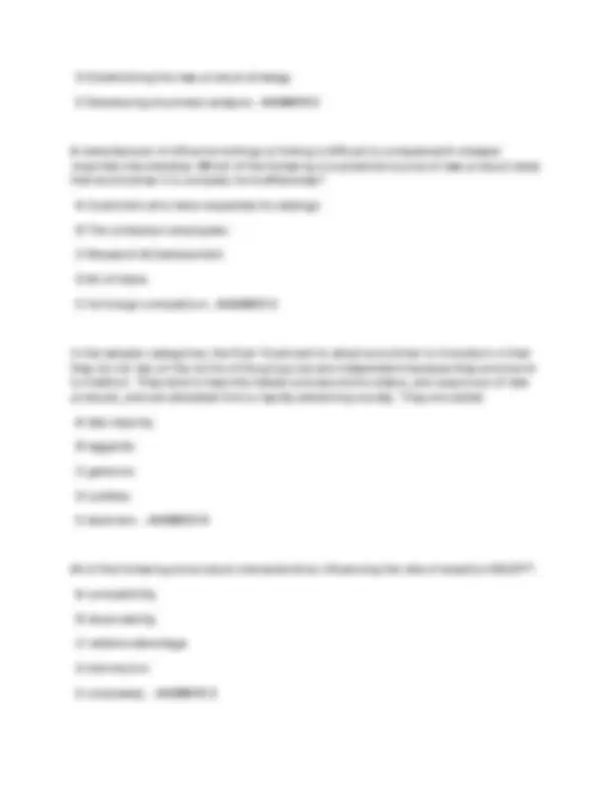
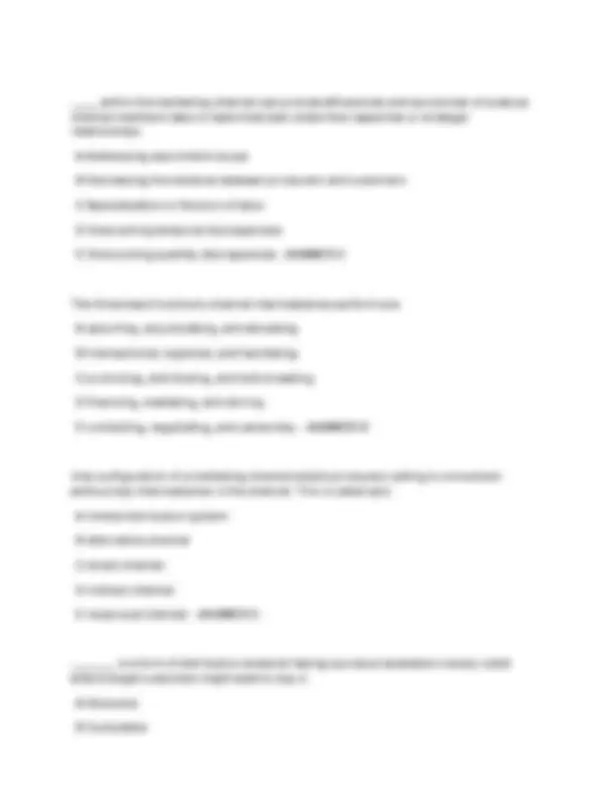
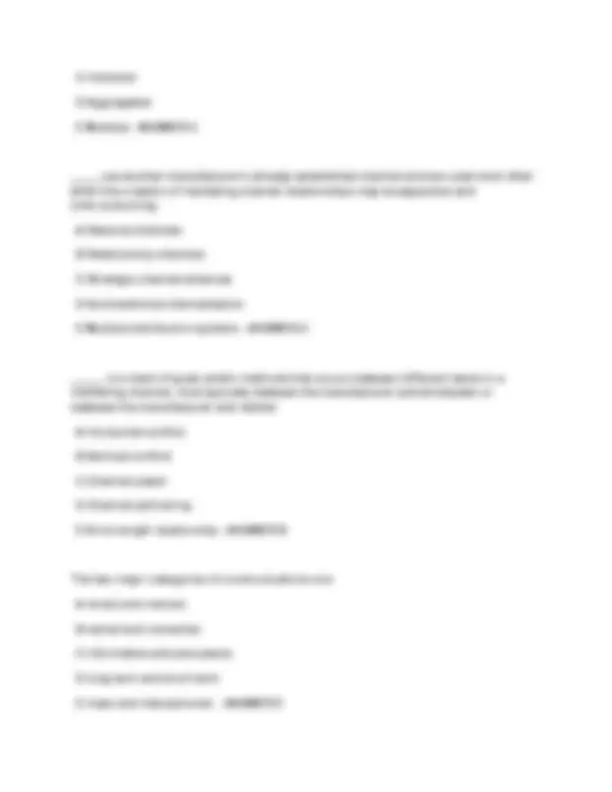
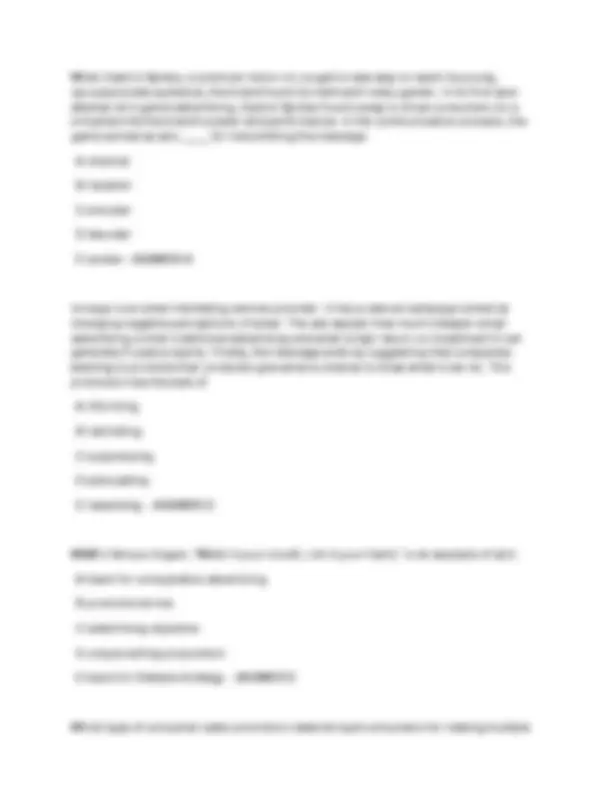
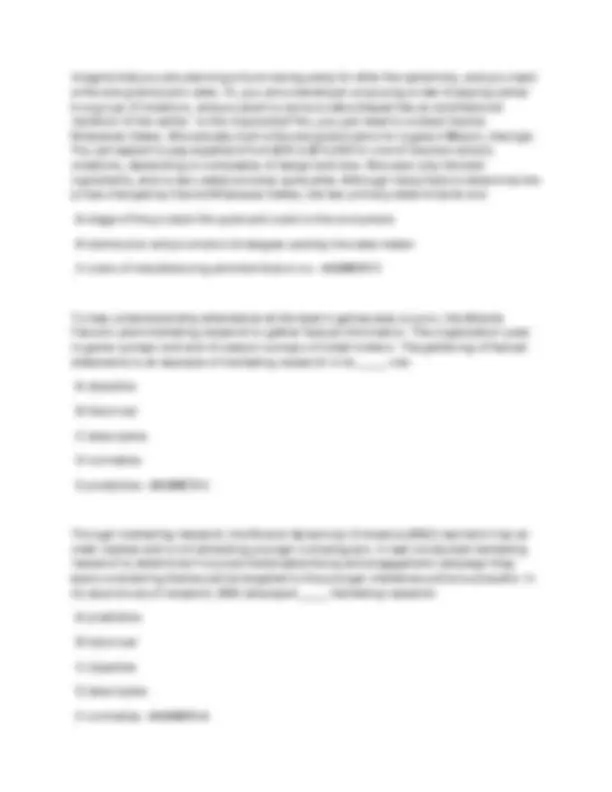
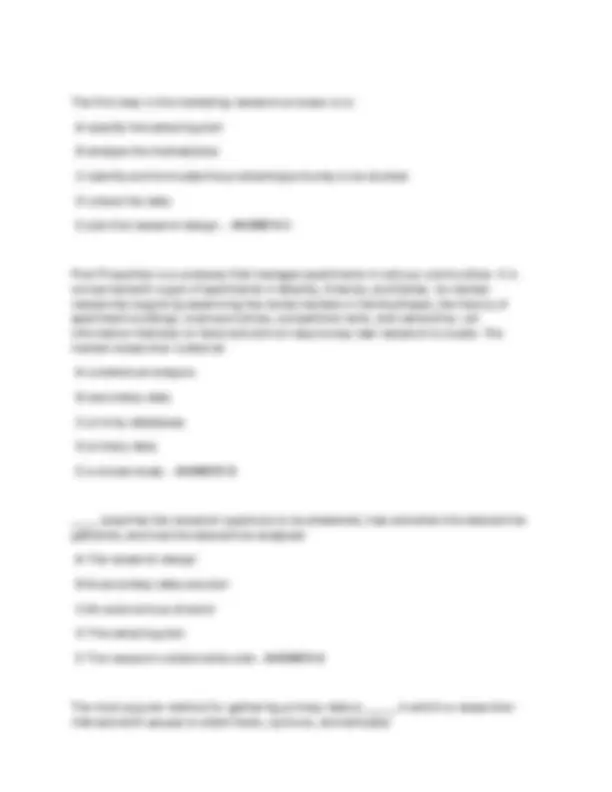
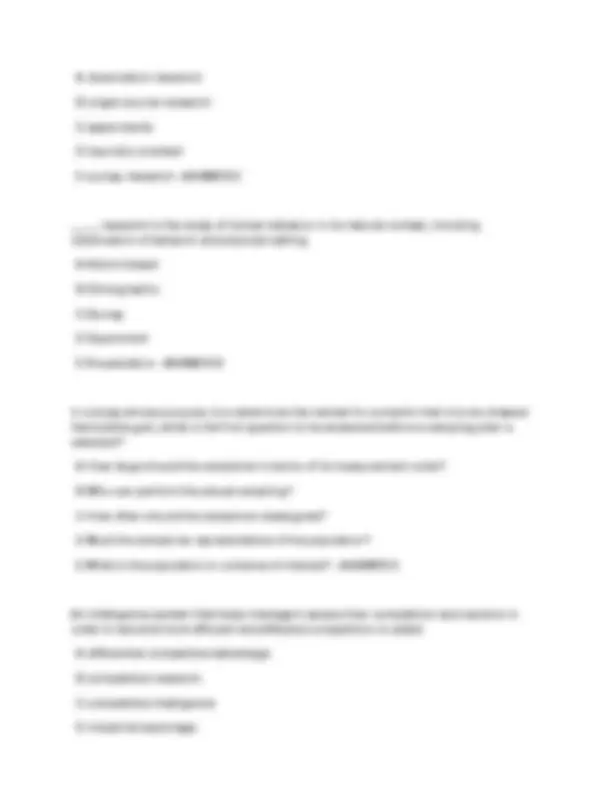



Study with the several resources on Docsity

Earn points by helping other students or get them with a premium plan


Prepare for your exams
Study with the several resources on Docsity

Earn points to download
Earn points by helping other students or get them with a premium plan
Community
Ask the community for help and clear up your study doubts
Discover the best universities in your country according to Docsity users
Free resources
Download our free guides on studying techniques, anxiety management strategies, and thesis advice from Docsity tutors
MKT 320F FINAL EXAM WITH 100% VERIFIED SOLUTIONS!!
Typology: Exams
1 / 21

This page cannot be seen from the preview
Don't miss anything!














Which marketing management philosophy focuses on the question, "What do customers want and need?" A. Sales B. Market C. Product D. Internal E. Production - ANSWER B
A company that wants to implement a market orientation would need to: A. do research on its customers, competitors, and markets. B. do all of the activities listed. C. establish and maintain mutually satisfying relationships with customers. D. determine how to deliver superior customer value. E. implement actions that provide value to customers. - ANSWER B
_____ is defined as the relationship between benefits and the sacrifice necessary to obtain those benefits. A Satisfaction percentage B Marketing utility C Market quality D Customer value E Opportunity cost - ANSWER D
_____ is a strategy that focuses on keeping and improving relationships with current customers.
A Organization-customer synergy B Market engineering C Relationship marketing D Transactional marketing E Commitment selling - ANSWER C
A business is concerned with many day-to-day activities. Some of the most important of these activities are the planning and development of a product, its ability to communicate value, its pricing policy, and the distribution strategy. These activities are all a part of: A human resources. B a control system. C accounting. D marketing. E production. - ANSWER D
Earl is starting a new bank. Before the opening day, Earl had a meeting with all employees. He discussed their mission, defined objectives for the bank for the coming years, and shared who their target market is. He talked about their product offerings and where their future branches would be located. Earl is sharing the bank's: A hierarchical restructuring. B reengineering. C financial analysis. D marketing plan. E strategic contingency. - ANSWER D
A firm that wants to develop a deeper understanding of its customers may optimize profitability, revenue, and customer satisfaction by focusing on highly defined and precise customer groups. This is _____: A sales orientation.
D brand name strategy E synergistic competitive advantage - ANSWER A
Arizona Tea is marketed by Vultaggio & Sons. Vultaggio & Sons took a basic drink and put it into unusual bottles with elaborate designs. The wide-mouthed, long-necked bottles are now considered to be trendsetters in the new age beverage industry, and customers often buy the tea just for the bottle. The success of Arizona Tea is based on: A a product differentiation competitive advantage. B reengineering. C supply-demand curves. D a cost competitive advantage. E a heterogeneous marketing strategy. - ANSWER A
Marketers can control the external environment in which their organizations operate. A True B False - ANSWER B
Marketers need a thorough understanding of the laws established by the federal government, state governments, and regulatory agencies. A True B False - ANSWER A
Which of the following statements best describes the typical target market? A. Target markets cannot be specifically defined according to age, income, or location, because these factors are continually changing. B. A target market will remain stable over time, including the same group of consumers. C. Target markets change over time as consumers drop in or out of the market, and as tastes change. D. Target markets are not strongly affected by changes in the external environment.
E. Target markets only change when the features and benefits of the product offering change. - ANSWER C
The external environment: A does not have an impact on Fortune 500 companies. B can be controlled in much the same manner as the internal marketing mix. C cannot be influenced by marketing managers. D must be continually monitored by marketing managers. E does not change over time. - ANSWER D
Americans' core value of upward mobility (i.e., success will come to anyone who works hard) has greatly influenced the way luxury goods are marketed. This phenomenon is an example of a(n) _____ factor. A economic B demographic C political and legal D technological E social - ANSWER E
The steps of the consumer decision-making process, in order, are: A. need positioning, stimulus response reactions, evaluation of alternatives, purchase decision, postpurchase evaluation B. information search, need positioning, evaluation of alternatives, product trial, purchase decision, postpurchase satisfaction C. need recognition, alternative aggregation, reevaluation, purchase decision, postpurchase behavior D. need recognition, information search, evaluation of alternatives, purchase, postpurchase behavior E. need positioning, alternative aggregation and divestment, purchase decision, postpurchase evaluation - ANSWER D
D It takes less effort - ANSWER C
A nationwide restaurant chain that varies its menu based on its location is an example of what kind of segmentation: A Geographic B Psychographic C Benefits D Demographic E Usage - ANSWER A
Clear Channel owns hundreds of radio stations across the U.S. How do they decide what kind of music to play on a particular station? A Demographic B Geographic C Psychographic D Usage E Benefits - ANSWER A
Procter & Gamble markets six different brands of laundry detergent, each targeting a different market segment. This is an example of concentrated targeting. A True B False - ANSWER B
Deciding who to target is the first step in market segmentation. A True B False - ANSWER B
"One-size-fits-all" marketing is largely out of date.
A True B False - ANSWER A
Procter & Gamble markets six different brands of laundry detergent, each targeting a different market segment. This is an example of multi-segment targeting. A True B False - ANSWER A
Deciding who to target is the last step in market segmentation. A True B False - ANSWER A
There are a number of detergents marketed under the Tide brand, including detergents with and without fabric softener, with and without bleach, with various pleasing smells, and fragrance-free formulations. These detergents are an example of Tide's: A product line. B product equity. C product mix. D mix consistency. E marketing mix. - ANSWER A
Tortilla chips are most likely _____ products, since they are purchased with little shopping effort. A generic B specialty C unbranded shopping D branded shopping E convenience - ANSWER E
D Establishing the new-product strategy E Developing a business analysis - ANSWER E
A manufacturer of office furnishings is finding it difficult to compete with cheaper imported merchandise. Which of the following is a potential source of new product ideas that would allow it to compete more effectively? A Customers who have requested its catalogs B The company's employees C Research & Development D All of these E Its foreign competitors - ANSWER D
In the adopter categories, the final 16 percent to adopt are similar to innovators in that they do not rely on the norms of the group but are independent because they are bound to tradition. They tend to have the lowest socioeconomic status, are suspicious of new products, and are alienated from a rapidly advancing society. They are called: A late majority. B laggards. C generics. D luddites. E decliners. - ANSWER B
All of the following are product characteristics influencing the rate of adoption EXCEPT: A compatibility. B observability. C relative advantage. D distribution. E complexity. - ANSWER D
Which of the following is not one of the stages of the product lifecycle? A Introductory stage B New product strategy stage C Maturity stage D Decline stage E Growth stage - ANSWER B
Profits typically reach their peak during the growth stage of the product life cycle. A True B False - ANSWER A
Sales typically reach their peak during the growth stage of the product life cycle. A True B False - ANSWER B
Services tend to exhibit more search qualities than do tangible goods. A True B False - ANSWER B
Which of the following is NOT one of the four unique elements to services? A Incoherency B Inseparability C Perishability D Intangibility E Heterogeneity - ANSWER A
Which of the following services would be most likely to exhibit strong credence
_____ within the marketing channel can provide efficiencies and economies of scale as channel members take on tasks that best utilize their expertise or strategic relationships. A Addressing assortment issues B Decreasing the distance between producers and customers C Specialization or Division of labor D Overcoming temporal discrepancies E Overcoming quantity discrepancies - ANSWER C
The three basic functions channel intermediaries perform are: A assorting, accumulating, and allocating. B transactional, logistical, and facilitating. C promoting, distributing, and bulk-breaking. D financing, mediating, and storing. E contacting, negotiating, and ownership. - ANSWER B
One configuration of a marketing channel entails producers selling to consumers without any intermediaries in the channel. This is called a(n): A limited distribution system. B alternative channel. C direct channel. D indirect channel. E reciprocal channel. - ANSWER C
________ is a form of distribution aimed at having a product available in every outlet where target customers might want to buy it. A Exclusive B Cumulative
C Intensive D Aggregated E Multiple - ANSWER C
_____ use another manufacturer's already established channel and are used most often when the creation of marketing channel relationships may be expensive and time-consuming. A Reverse channels B Relationship channels C Strategic channel alliances D Nontraditional channelization E Multiple distribution systems - ANSWER C
______ is a clash of goals and/or methods that occurs between different levels in a marketing channel, most typically between the manufacturer and wholesaler or between the manufacturer and retailer. A Horizontal conflict B Vertical conflict C Channel power D Channel partnering E Arms-length relationship - ANSWER B
The two major categories of communications are: A direct and indirect. B verbal and nonverbal. C informative and persuasive. D long term and short term. E mass and interpersonal. - ANSWER E
purchases of a particular good or service? A A premium program B An 80/20 program C A net worth program D A continuity program E A frequent buyer program - ANSWER E
Angela and Dominic own Cincy by the Slice pizzeria. They are interested in keeping track of the number of mentions their store receives on sites like Twitter and Facebook, but they are unsure of which steps to take next. Which of the following resources would best meet their needs? A A social customer relationship management system B An advanced customer database with predictive application C A listening platform with key word report capabilities D An insight platform that offers online focus group solutions E Web analytics software - ANSWER C
Cutting costs is the best way to maximize profitability. A True B False - ANSWER B
Willingness to pay is a way to measure demand elasticity. A True B False - ANSWER A
Assume a firm sells 1M units of its product for $10 and has a 30% gross profit margin ($3). Cutting the price to $9.50 might stimulate unit sales by 10%. Will the assumed increase in sales volume offset the decrease in margin? A Yes, the increase in sales will offset the decrease in margin due to increased
demand. B No, the increase in sales will not offset the decrease in margin. C There is no way to tell without knowing variable and fixed costs. - ANSWER B
Which of the following statements about yield management systems (YMS) is true? A YMS eliminate the problem of simultaneous production and consumption from services. B The first use of YMS was in the U.S. car industry as it looked for ways to compete with imports. C YMS are complex pricing systems used to set equilibrium pricing points. D YMS cannot be used by any other businesses but services. E YMS are mathematically complex systems to make use of underutilized capacity and reduce the cost of perishability. - ANSWER E
Although many factors can influence price, the primary determinants are: A costs of manufacturing and distribution. B demand by the consumer and perceived quality. C the demand for the good and the cost to the seller. D stage of the product life cycle and costs to the consumer. E distribution and promotion strategies. - ANSWER C
With value-based pricing: A the firm is both customer driven and competitor driven. B increased profitability for wholesalers will increase the number of services they are willing to perform. C the firm is sales driven. D additional long-term costs to manufacturers will increase. E consumers are more concerned about price than quality. - ANSWER A
The first step in the marketing research process is to: A specify the sampling plan. B analyze the marketplace. C identify and formulate the problem/opportunity to be studied. D collect the data. E plan the research design. - ANSWER C
Post Properties is a company that manages apartments in various communities. It is concerned with a glut of apartments in Atlanta, Orlando, and Dallas. Its market researcher begins by examining the rental markets in the Southeast, the history of apartment buildings, local economies, competitive rents, and ownership — all information that was on hand and did not require any new research to locate. The market researcher looked at: A a statistical analysis. B secondary data. C priority databases. D primary data. E a closed study. - ANSWER B
_____ specifies the research questions to be answered, how and when the data will be gathered, and how the data will be analyzed. A The research design B A secondary data use plan C An autonomous director D The sampling plan E The research collaborative plan - ANSWER A
The most popular method for gathering primary data is _____, in which a researcher interacts with people to obtain facts, opinions, and attitudes.
A observation research B single-source research C experiments D heuristic oriented E survey research - ANSWER E
_____ research is the study of human behavior in its natural context, involving observation of behavior and physical setting. A Action-based B Ethnographic C Survey D Experiment E Visualization - ANSWER B
In a study whose purpose is to determine the market for a vitamin that is to be chewed like bubble gum, what is the first question to be answered before a sampling plan is selected? A How large should the sample be in terms of its measurement costs? B Who can perform the actual sampling? C How often should the sample be redesigned? D Must the sample be representative of the population? E What is the population or universe of interest? - ANSWER E
An intelligence system that helps managers assess their competition and vendors in order to become more efficient and effective competitors is called: A differential competitive advantage. B competitive research. C competitive intelligence. D industrial espionage.